The Pygmalion myth in Ovid’s “Metamorphoses” and William Schwenk Gilbert’s “Pygmalion and Galatea”
Abstract
This article examines the ambivalent nature of the Pygmalion myth in Ovid’s Metamorphoses and William Schwenk Gilbert’s Pygmalion and Galatea (1870). The versions of the myth in Ovid and Gilbert are regarded as attempts at demythologization, which paradoxically introduce their own mythology. The author argues that the myth serves as both a reality and an illusion for the protagonists, blurring the lines sbetween critical knowledge and mythological worldview. Drawing on conceptual metaphor theory, the author suggests that the Pygmalion myth can be regarded as an allegory within the cognitive paradigm of embodied realism, and the unconscious metaphor behind the myth presents the metamorphosis as rationally explainable yet resistant to critical thinking. The article delves into Pygmalion’s mythical consciousness, highlighting his self-deception and the dialectic between animation and petrification. In Ovid, Pygmalion’s mastery achieves a perfect delusion. He believes in the possibility of animating his statue because it is so life-like. The original story – as we know it from Ovid’s Metamorphoses – treads the line between a miracle and self-delusion. After Ovid, its nature has remained ambivalent over the centuries. Gilbert demythologizes the myth by allowing it to become authentic reality. Pygmalion’s dream is realized to reveal its paradoxical consequences, which change the phantasmagoria of animation into a waking nightmare. The dialectic of the myth is realized through legitimating the magical act of creation and challenging its ramifications. Animation is possible in its initial stage, but the education and socialization of Galatea seemingly fail. The only way out of this predicament appears to be the reverse act of petrification. Pygmalion’s illusion has to come full circle in order to restore the balance. The article concludes that the understanding of the Pygmalion myth requires balancing between mythologizing and demythologizing, knowing and not-knowing.
Downloads
References
Assmann, A. (1997). Belebte Bilder: Der Pygmalion-Mythos zwischen Religion und Kunst. In Pygmalion: die Geschichte des Mythos in der abendländischen Kultur (pp. 63–87). Eds. M. Mayer, G. Neumann. Freiburg im Breisgau: Rombach.
Blühm, A. (1988). Pygmalion. Die Ikonographie eines Künstlermythos zwischen 1500 und 1900. Frankfurt a.M.: Peter Lang.
Denysko, P. (2021). Insait. Vizualni y multymodalni metafory v zhyvopysi, skulpturi, kino ta inshykh vizualnykh mystetstvakh [Insight: Visual and Multimodal Metaphors in Painting, Sculpture, Cinema, and Other Visual Arts]. Poltava: FOP Hovorov S.V.
Didi-Huberman, G. (2005). Confronting Images: Questioning the Ends of a Certain History of Art. Trans. J. Goodman. University Park: The Pennsylvania State University Press.
Dörrie, H. (1974). Pygmalion. Ein Impuls Ovids und seine Wirkungen bis in die Gegenwart. Opladen: Westdeutscher Verlag.
Gilbert, W. S. (1870). Pygmalion and Galatea. An entirely original mythological comedy. New York: T.H. French. http://archive.org/details/pygmaliongalatea00gilb (accessed 17 July 2023).
Gross, K. (2019). The Dream of the Moving Statue. Ithaca, NY: Cornell University Press.
Haynes, M. (2023). The Skin of a Statue: Rethinking Ovid’s Pygmalion. The Sculpture Journal, 32(2), 175–191. https://doi.org/10.3828/sj.2023.32.2.03
Horkheimer, M., Adorno, T. W. (1972). Dialectic of Enlightenment: Philosophical Fragments. Trans. J. Cumming. New York: Herder & Herder.
Joshua, E. (2001). Pygmalion and Galatea: The History of a Narrative in English Literature. Aldershot: Ashgate.
Lakoff, G., Johnson, M. (1999). Philosophy in the Flesh: The Embodied Mind and Its Challenge to Western Philosophy. New York: Basic Books.
Lakoff, G., Johnson, M. (2003). Metaphors We Live By. Chicago: The University of Chicago Press.
Lakoff, G., Turner, M. (1989). More Than Cool Reason: A Guide to Poetic Metaphor. Chicago: The University of Chicago Press.
Miller, J. M. (1988). Some Versions of Pygmalion. In Ovid Renewed. Ovidian Influences on Literature and Art from the Middle Ages to the Twentieth Century (pp. 205–214). Ed. C. Martindale. Cambridge: Cambridge University Press.
Miller, J. H. (1990). Versions of Pygmalion. Cambridge: Harvard University Press.
Ovid. (1958). Metamorphoses. Ed. and trans. F. J. Miller. Vol. 2 (pp. 81–85). London: Heinemann. http://archive.org/details/metamorphoseswit02oviduoft (accessed 17 July 2023).
Shopin, P. (2013). The Myth of Language in G. B. Shaw’s Pygmalion. Mova i kultura, 16(2), 282–286. URL: http://nbuv.gov.ua/UJRN/Mik_2013_16_2_50 (accessed 17 July 2023).
Shopin, P. (2014). Postmodern Pygmalionism. Visnyk Luhanskoho natsionalnoho universytetu imeni Tarasa Shevchenka. Filolohichni nauky, 6(2), 77–86. URL: http://nbuv.gov.ua/UJRN/vluf_2014_6%282%29__14 (accessed 17 July 2023).
Shopin, P., Bentia, I. (2023). The Myth of Materialism and the Subject of Modernity: Pygmalion in the Works of André-François Boureau-Deslandes and Jean-Jacques Rousseau. Artistic Culture. Topical Issues, 19(1), 192–199. https://doi.org/10.31500/1992-5514.19(1).2023.283357
Weiser, C. (1998). Pygmalion: vom Künstler und Erzieher zum pathologischen Fall; eine stoffgeschichtliche Untersuchung. Frankfurt a.M.: Peter Lang.




